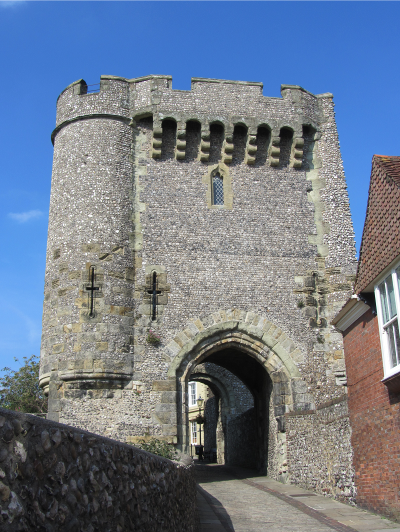
|
A Brief History of LewesMartin Cohen, author and Lewesian, offers a personal overview of the history of Lewes and particular issues of archaeological interest. |
The history and archaeology of Lewes is full of mysteries and disputed suppositions.
Even the town’s name is something of a mystery. One theory has it that its comes from the Anglo-Saxon "Hlaew", which means "hill" but other sources say that it derives from the rare Old English word lǣw meaning ‘wound, incision’, being used in a topographical sense for ‘gap’. A third idea advanced by Richard Coates in particular, is that the name corresponds to the notion of ‘slope’.
And a final very different but intriguing theory is that it comes from the river the town grew up by – but is nowadays mispronounced. L’Ouse, so to speak.
As for the origins of the word “ouse’ itself, etymologists say it comes either from the Celtic word usa meaning simply water or the Saxon word for mud from which the modern word ooze derives. Today the river is small and indeed muddy, but melting glaciers at the end of the last Ice Age made it many times bigger. With the aid of a much greater gradient it cut a broad sweep through the soft chalk downlands of Sussex on its way to the English Channel. The mouth of the river was not always static until it was diverted from Seaford to Newhaven (hence the name, of course) in around 1539. “French raids, an inundation of the sea and the plague all contributed to Seaford’s demise” says David Worsell - but presumably the works relocating the Ouse to Newhaven can’t have helped!
Whether or not Lewes’s name comes from the river, certainly the story of the town revolves around it. John Houghton says in a booklet called ‘The Great River of Lewes’ (pamphlet credited to Parchment, Oxford, 2002) that Lewes was originally sited on a promontory sticking out into a marshy and regularly flooded area.
Martin Welch argues that the town’s strategic location, guarding the first crossing point at the top of a key estuary, explains its early importance and development. He notes that Lewes was also one of very few towns to be given the title ‘urbs’ in Aethelstan’s coinage, and that the discovery of a glass armlet (now lost) and a five-spiral ornamented cast saucer brooch at Malling Hill points at occupation in the middle or even early Saxon period. However, as Fiona Marsden points out, ornaments alone do not definitively prove settlement even if women were accompanying warriors. At this time there were two separate peninsulas, one at Malling and one at Southover, both marked by Saxon cemeteries at their landward ends, (the traces of which we’ll come to in more detail, later).

In administrative terms anyway, it seems that the origins of Lewes lie in its being one of four late Saxon bur(g)hs, or fortified settlements mentioned in the 10th century Burghal Hidage describing the then Wessex.
The town’s status as a burh is well documented, although archaeological evidence from this period has proved elusive. However, in 2008 excavations on the site of the Baxter’s printworks in Saint Nicholas Lane (just off Lewes High Street) produced:
“an embarrassment-of-riches from the 9th to 11th centuries including a stretch of the defensive ditch marking the edge of the burh (the first physical evidence of this feature), and a hoard of seventeen silver pennies from the reign of Edward the Elder, 899-924 AD.”.
(Report by Simon Stevens on the Baxters excavation, in Sussex Past & Present (The Sussex Archaeological Society Newsletter No. 11 November 2000) PDF available online at: https://sussexpast.co.uk/wp-content/uploads/2011/08/SPP-116-Dec-08.web_.pdf ).
When Lewes featured in a television series about English architecture, presented by the historian, Alec Clifton Taylor, and in a book derived from the series called ‘Six English Towns’, (BBC 1981) Mr Clifton Taylor supposes that the town originated at some point in the 8th century, and “perhaps not much before 900”.
There are two Anglo-Saxon cemeteries near the town: one at Malling Hill and the other at Saxonbury [sic] House, in what is now the village of Kingston near Lewes, and then would likely have been part of the area of Southover which is known to have had an early Saxon church. In a small book called, ‘Sussex River: Lewes to the Sources’, Edna and ‘Mac’ MacCarthy mention that another monastery, St Michael’s at Malling was endowed around the year 765 by Eadwulf, ‘a king in the Sussex region’.
Dudley Moore in The Archaeology of the Ouse Valley, Sussex to AD 1500 (edited by Dudley Moore, Michael Allen and David Rudling (Archaeopress 2016)), supposes that the river must have been “a corridor of communication from the Palaeolithic period onwards”, and suggests rather optimistically that it would have been fully navigable by “fully-rigged schooners” in the 13th and 14th centuries. He argues that silting and movement of shingle on the coast made the river unsuitable for larger vessels probably around the end of the 16th century. John Houghton notes, that in the 1820s, barges “45 feet long and 12 feet wide could come up from Newhaven to Lewes’.
Documentary sources, in particular the Law of Aethelstan - ca. 925/30 reveal that by the early part of the 10th century, the town was important enough that it was one of only a few permitted to mint coins by King Aethelstan (925-940) regarded by historians as one of the greatest Anglo-Saxon kings and the first king of England.
“Thirdly [we declare] that there shall be one coinage throughout the king's realm, and no man shall mint money except in a town.... In Canterbury there shall be seven moneyers: four for the king, two for the archbishop, one for the abbot. In Rochester, two for the king and one for the bishop. In London, eight; in Winchester six; in Lewes two; in Hastings one; another in Chichester; two in Southampton; two in Wareham; [one in Dorchester]; two in Exeter; two at Shaftesbury; and one in [each of] the other boroughs.”
(See: http://users.trytel.com/tristan/towns/florilegium/introduction/intro06.html).
There is again some mystery as to why Lewes should have been considered so important. Could it have been that the town (or rather the geographical position) had some long lost, Pagan significance? John Blair points out that Sussex was the last county to ‘connect’ fully to Christianity. Fiona Marsden speculates that the prestigious Cluniac Order may have agreed to found a priory at Lewes - after declining to do so at London - out of ‘a sense of mission’ to combat enduring Pagan beliefs.
In the centuries before 1700, the southern part of England was sparsely populated, and certainly less so than regions like today’s East Anglia. “Between London and Bristol, there were no large towns and remarkably few little ones” writes David Hackett Fisher, in a book called Albion's Seed: Four British Folkways in America (Oxford University Press) which is a history of American that starts in England. In the year 1600, for example, Mr Hackett Fisher explains, the entire county of Hampshire contained only two towns as large as 3,000 inhabitants—Winchester and Southampton. Only six Hampshire settlements were above 1,000 inhabitants: Alton, Andover, Fareham, Basingstoke, Petersfield and Portsmouth. And in Dorset, the largest town was Dorchester with 1,500 souls. Thus, in Sussex, Chichester and Lewes could dominate despite themselves having barely as many as 2,000 inhabitants.
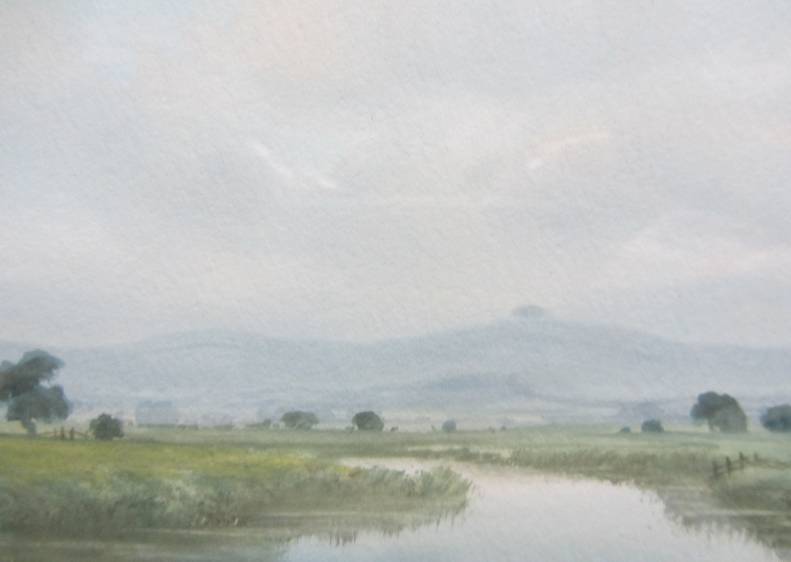
And then there is Lewes’s place on the river. John Houghton speculates that for many years Lewes “had the only bridge inland from the sea and was the only significant crossing place”. He says that the early high point of the tides was near Lewes bridge, and that a bridge there is on record as being repaired in 1159.
C ertainly,
at Newhaven, records refer to one Rico Ferne of South Heighton as
holding the ferry rights in 1322, and that travellers had to go as
far inland as Lewes to find the first bridge. The first bridge at
Newhaven wasn’t constructed until after an Act of 1784 and was
a very grand drawbridge affair.
ertainly,
at Newhaven, records refer to one Rico Ferne of South Heighton as
holding the ferry rights in 1322, and that travellers had to go as
far inland as Lewes to find the first bridge. The first bridge at
Newhaven wasn’t constructed until after an Act of 1784 and was
a very grand drawbridge affair.
South of Lewes, there were ferry crossings however, including one at Stock Ferry, near Southease. Houghton notes the story that in 1576 a man brought 58 sheep to the ferry and was drowned, together with John Hersell, the keeper of the ferry, when the sheep panicked and all crowded down one end of the ferry, in the famous manner of sheep everywhere, thereby causing it to tip over and then sink. Documents for the inquest reveal that each sheep was valued at five shillings - and the boat itself at a meagre ten shillings.
Today, Lewes straddles a better controlled and much quieter river with two road bridges – the Cliffe and Phoenix – and one small footbridge – Willeys, and it is hard to imagine the town once sheltering on a spur of land above a great river plain as it must have been for many centuries.
According to John Houghton again for example, there were floods recorded in the Ouse valley in 1274-5, 1285, 1331-2 and 1341. “The low-lying estates of Kingston and Iford were almost the whole year under water, and in 1421 there was a great autumn flood…” that occasioned a special Commission the year following. After another ‘great storm’ in 1509 the value of the Priory brook lands was recorded at only two pence per acre since they were ‘almost the whole year under water’. It was in fact because of the flooding upstream that the Commissioners agreed in 1537 to start “cutting the haven right to the sea now called new haven”.
Various natural bends and meanders were removed, and the flow of the water increased. However, the new route seems ultimately to have only restored the river to its earlier course, as other sources point to the Ouse as having ‘debouched’ in Roman times at the settlement that later became Newhaven on the coast, which fits with theories that it was Anglo-Saxon activity that had the effect of slowing the river’s flow that caused it to start it’s move eastward towards Seaford. Excavations at Newhaven in 1971 found traces of a small Roman villa that had been systematically demolished in the second century AD.
Edna and “Mac” MacCarthy say that “during the 12th and 13th centuries several thousands of acres of land belonging to the Archbishop’s Manor of South Malling were cleared. They specifically mention a report dated 1273 of timber being ‘cropped’ for making hop poles, and oak may have been of considerable value for buildings and indeed boats. The MacCarthys also note a Parliamentary Act of 1543 that ordered a percentage of ‘storers’ should be retained when woodland was cleared - clusters of trees containing a variety of species. This however, may be less due to enlightened concern for the environment as such, and more due to the competing interests of nobility and peasants. The latter being inclined to laboriously create fields and the former wanting landscapes suitable for hunting. And by this time, the authors note, Lewes itself had several granaries and brewers and “more taverns than any other town in Sussex”.
It is thought that it was the narrowing and taming of the river inland in the Saxon period that resulted in the build-up of shingle at the river mouth, and the river’s displacement eastwards towards Seaford, which at one point became important enough to be one of the Cinque Ports.
However, the change to the river’s course did not solve the problem of flooding around Lewes, as a report in 1724 makes clear. In this, a Captain Marwick complains that the proposed work on the river would not “add one jot to the draining of the marshlands about Lewes, but rather make it worse”.
The residents and councilors of Lewes who were so unpleasantly surprised to find water in their homes in 2000, did not know or remember that Lewes was built around access to a great river estuary.
In October 2000, heavy rain combined with a tidal surge to cause extensive flooding to Lewes. A report by Binnie Black and Veatch (March 2001) into the causes of the flood identified that 613 residential and 207 business properties were flooded, along with 16 public buildings. 503 vehicles were damaged or destroyed and the total cost of the flooding was given as £88 million. Newer residents were astonished to see how their humble river could turn into a sea, but of course, from the longer perspective it was anything but unexpected. 1960 had been another bad year for flooding.
David Millum reports Gardiner’s view that the town’s northern and low-lying ‘Cliffe’ section was “largely built on a chalk causeway laid across the Ouse floodplain involving vast amounts of chalk being quarried from the nearby Downs escarpment and compacted into a firm base on which to raise buildings”. And, that excavations of the Priory grounds in the late 1980s revealed a “hard for beaching ships”.
There is also another way in which the river has had a very practical effect on Lewes. In 1410, documents refer to a dispute between the Earl of Arundel and the Archbishop of Canterbury which hinged on the right of boats to travel the river beyond Lewes. It seems the settlement created a division at the area known as the Cliffe, a legal barrier which may have lasted until the end of the 18th century - when the Waterway Commissioners were created.
T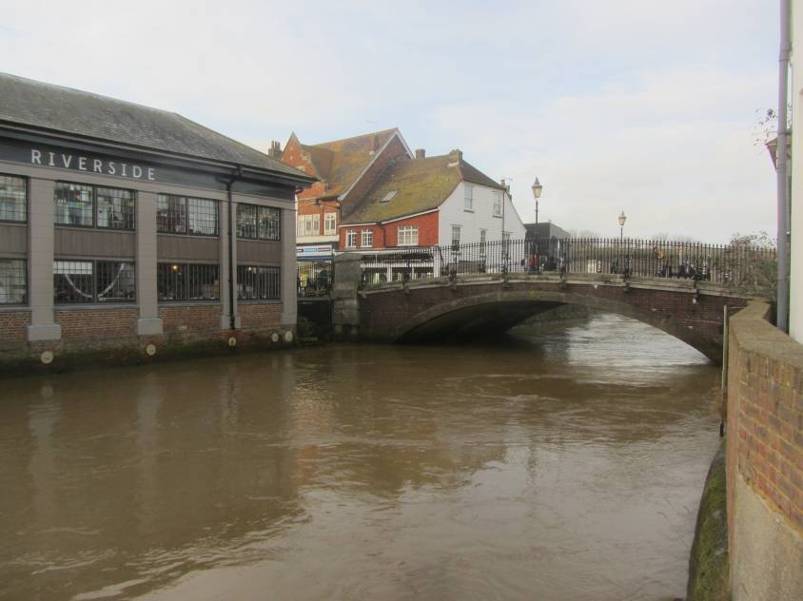 he
iron bridge you see today between Lewes proper and the Cliffe was
built in 1727, following floods two years earlier that had swept away
the previous one. An inscription on the north side testifies to this
date. The bridge is actually two bridges now joined under a common
road surface, marking the meeting point of two canal systems.
he
iron bridge you see today between Lewes proper and the Cliffe was
built in 1727, following floods two years earlier that had swept away
the previous one. An inscription on the north side testifies to this
date. The bridge is actually two bridges now joined under a common
road surface, marking the meeting point of two canal systems.
Lewes has never been significant either for its industries or its farming – but rather grew out of its strategic position in
the Ouse valley both as a river crossing and as a port. Even today, several large warehouses on the river attest to its historic role carrying: “Southdown corn and Wealden guns” down river and “spices, wines, silks and cheese” up river, at least those are the good imagined by Sylvia Antunovich in a popular account for the Magazine ‘This England’ in Autumn 2004.
A more prosaic and practical account of Lewes’ trade appears in the MacCarthys’ pamphlet, saying that the ships, which were limited in size to about 30 tons, would have carried iron goods, “pots, pans, anvils etc.” as well as cannon and shot under licence.” Records show that Richard Bishop exported iron ordnance to London and West Country, as well as to St. Malo and La Rochelle; he imported wine, salt and fish. Ralph Akehurst of the [the] Cliffe traded with Ireland, Dieppe, Calais and Flushing… By the 17th century fish, spices, prunes, hops, vinegar, salt, textiles, paper, glass and ‘Newland’ tobacco featured in the distributive trade of Lewes as well as soap, groceries, sugar, liquorice, wine and agricultural produce.”.
Today little remains of the town’s wharves. Alan Hill says that the dock walls of Every’s Wharf are still visible “though the foundry site has changed beyond recognition’ because the many surviving buildings are hidden under modern cladding. Southerham Dock, however, has changed much less since 1938 when it was last used, although the cement works it served has disappeared to become an industrial estate. And both Cliffe Bridge and its line of Victorian warehouses remain.
It was as a port collecting customs that Lewes attracted its celebrated philosophical associations, most notably with Thomas Paine, the 18th century writer and campaigner whose pamphlets concerning the ‘Rights of Man’ were pivotal in the American Revolution.
“The timing of Common Sense was perfect, for it provided a blanket indictment of British royalty in general and George III in particular just as the news of his plan to launch an enormous invasion began circulating in the American press. The pamphlet’s style, message, and timing combined to make it a sensation that sold 150,000 copies within three months.16
The author, it turned out, was a thirty-nine-year-old Englishman named Thomas Paine, who had taken up residence in Philadelphia only two years earlier. Nothing in Paine’s background marked him as a candidate for greatness. He had failed as a shopkeeper, husband, and corset maker in Lewes and London, though he had internalised a keen sense of British injustice based on his experience as a member of London’s impoverished working class. As for his dazzling prose style, it was like a beautiful woman’s beauty, a God-given gift that was simply there. Since no one had ever heard of Paine, and since John Adams was the most visible and outspoken advocate for American independence, Adams was initially identified as the author of Common Sense. “I am innocent of it as a Babe,” Adams retorted. “I could not reach the Strength and Brevity of his style. Nor his elegant Simplicity nor his piercing Pathos.”
(Joseph Ellis, Revolutionary Summer: The Birth of American Independence (Doubleday 2013)).
As I myself noted in a book on political philosophy, it was whilst working for the Excise Board in Lewes that Paine became interested in politics. He became politicised while officially investigating the poor pay and conditions of Excise Officers (see “Thomas Paine – The Case of the King of England and his Officers of Excise” – George Hindmarch 1998 and “Thomas Pain in Lewes 1768-1774 – A Prelude to American Independence” ed. Paul Myles 2009).
Paine started holding heated political discussions of Locke’s ideas in the White Hart Inn, still there and still much the same, on Lewes High Street. As to philosophy, Paine once remarked refreshingly of his debt to his political forbear, if also rather dismissively, that he had ‘never read any Locke, nor ever had the work in my hand’. Indisputably though, it was Locke’s ideas that made the running in those political debates in the White Hart. Plaques at two Public Houses, the Bull Inn (from where he ran a grocery business) and the White Hart in Lewes High Street commemorate Lewes’ links to this revolutionary thinker.
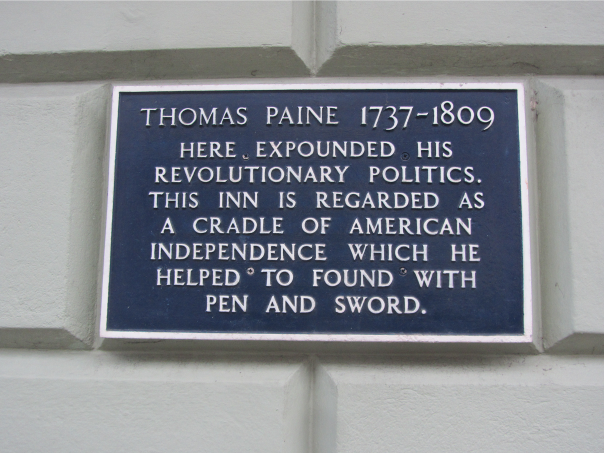
In fact, Lewes is festooned with plaques revealing the town’s many and diverse associations. Gideon Mantell (1790-1852), whose attempts to reconstruct the structure and life of Iguanodon led to him being often credited with being founding the scientific study dinosaurs, lived in Castle Place, according to the story, originally attracted to it in part by the ammonite columns that adorn the pilasters. Less celebrated is the town’s association with the discovery of the so-called ‘missing link’, bones uncovered at the nearby Piltdown gravel beds by Charles Dawson and associates which, in the absence of not only carbon dating techniques but critical examination generally, appeared to confirm for nearly a generation Darwin’s ideas about the ‘Descent of Man’. (In reality, the bones discovered were not parts of a long-buried pre-hominioid but rather several animal bones, artfully chosen and arranged alongside to deceive.)
(Speaking of old fossils, the archaeology of the Ouse Valley has attracted much interest with, as one archaeologist notes ruefully, shedloads of flint fossils... but in reality the current state of knowledge is ‘speculative’ and subject to constant revision.)
Throughout the 19th century historians were adamant that Lewes must have had an important role in Roman England. For one, “Lewes was the first Roman station on Ermine Street”, as John Bleach notes, adding that the respected Gideon Mantell thought he had discovered a Roman ritual deposit at the bottom of his garden in Lewes High Street including in some accounts, animal bones and in other accounts, several Roman coins .
But then another Lewes Myth concerns the town’s Roman Road. This is listed as Margary 14, the ‘London to Lewes’ by historians. Margary numbers constitute the numbering scheme developed by the historian Ivan Margary to catalogue known and suspected Roman roads in Britain in his 1955 work The Roman Roads of Britain. But the name is misleading as the road only went as far as the village of Barcombe north of today’s town, and where traces of a Roman Villa and a possible industrial settlement have been discovered. See also The London-Lewes Roman Road. A Guide to the Visible Remains at Holtye and on Ashdown Forest by Margary, Ivan D (Lewes: The Sussex Archaeological Society, 1939. Pamphlet.)
There are two good ways to identify Roman roads. One is simply to look at maps, and see where actual roads still pursue absolutely straight lines that often seem not to relate to actual settlements. The other is to dig for physical evidence, as Roman roads consisted of several layers of rocks which, if they were not taken long ago for building, in places can still be unearthed. Such evidence was uncovered at Barcombe, to the north of Lewes- along with traces of a Roman villa.
If Lewes does not seem to really have had any significance for the Romans, at least, it does appear in two entries in Domesday Book, recorded as having 127 households, making it then a ‘very large’ settlement.
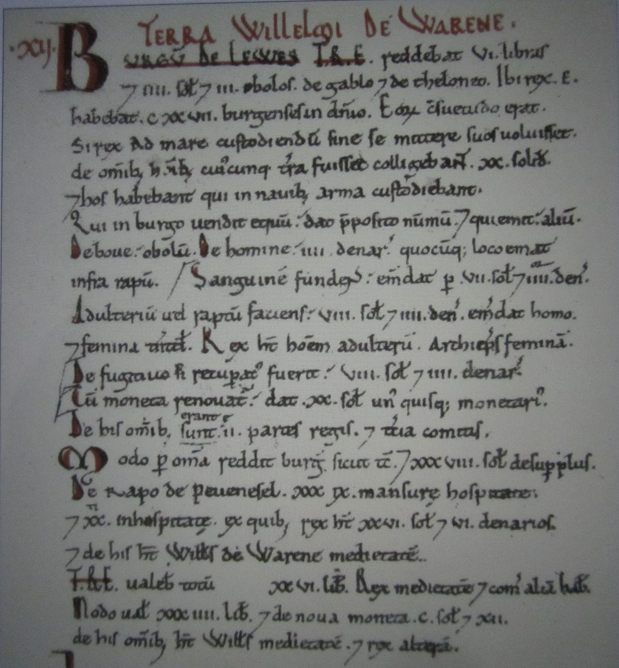
|

|
| ([http://opendomesday.org/book/sussex/02/: Professor JJN Palmer and George Slater) |
The tidal nature of this enlarged Ouse valley is reflected by the references in the Domesday Book to numerous salt-works in the area.
According to Thomas Walker Horsfield writing in The History and Antiquities of Lewes and Its Vicinity, Volume 1, (Baxters, Lewes, 1824) at the time of the Conquest, the houses of Lewes were built of wood and covered in reeds. The fire was in the centre of the floor and there was no chimney making the air inside smoky and foul.
It should be noted, however, that Iford, today a forgotten neighboring village a mile away from Lewes across the flood plain, was larger with 175 households, and Malling (then entirely separate but today a northern estate within ‘Lewes’) had 310 households. The average rent paid by the Lewes households was only 7 old pennies, with Lewes paying instead a considerable ‘fish rent’.
Domesday Book entry for Lewes
Whoever sells a horse in the borough gives to the reeve 1d [1 penny] and the buyer [gives] another; for an ox 1/2d; for a man, wherever he may buy him within the rape, 4d. A man who sheds blood pays a fine of 7s4d.[7 shillings four pence] A man who commits adultery or rape pays a fine of 8s4d, and a woman as much.
The King has [the penalty from] the adulterous man, the archbishop [from] the woman. From a fugitive, if he is retaken, 8s4d. When the mint is renewed, each moneyer gives 20s.
(National Archives Source: E31/2/1 f.26).
The Domesday Book records that parishes like those of Iford and Rodmell paid part of their annual rent in herrings: 16 000 and 4 000 respectively. The fish would have been caught in nets staked up in the fields about to be inundated by the rising tide, with the fish trapped in them as it fell back. The technique was called a ‘fish kettle’ and gave the English language its saying: ‘a pretty kettle of fish’.
In Sussex the administrative districts were known as rapes. These were sizeable areas of land, usually named after the rape’s main town, each stretching from north to the south east coast. Each rape had a castle, a mint and a sheriff, evidence of its military and commercial importance.
In the entry for the rape of Lewes the details of horse and ox sales allude to the market, the moneyers to the mint. Details of the sums owed the King raised through fines are included. This indicates the number of hides, or the size and wealth of the settlements, Lewes being counted at 1300 hides, with a circumference wall of 5363 feet long indicated by the text (David Rudling, 1983). And at the time of the Conquest it was valued at £26 per annum which was more than double the value of Chichester – which was valued at a mere £12.
From the end of the 17th century Lewes’ role as an administrative centre was entrenched in the status of being the county town of Sussex.
LEWES AND ITS CASTLE
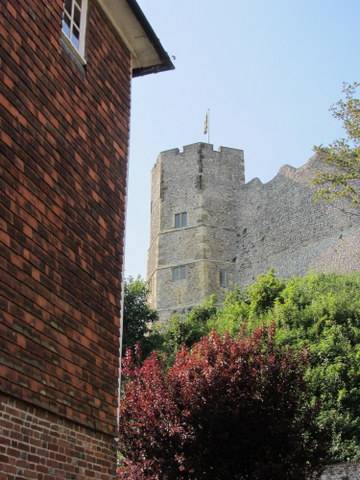
Another archaeological mystery and historical dispute concerns the town’s
castle, built soon after the Battle of Hastings in 1066 –
making it one of the oldest castles in England. To be more precise,
following William the Conqueror’s victory at Hastings, his
right-hand man, William de Warenne was give Lewes along with many
other rich prizes, and decided to upgrade whatever defensive
structures were there into a fine Norman Castle.
But exactly what this involved remains less clear. It is often stated confidently that the castle was constructed on one mound, as it is today, and as was indeed the pattern for Norman Castles. Yet, there is, indisputably, a second mound, today a grass covered oddity, called ‘Brack Mount’. Archaeologists and locals alike have speculated as to why this might be, with some suggesting for example that perhaps the first mound, proved to be unsatisfactory, perhaps unstable, and thus exists only as a relic, too much trouble to dismantle.
Likely, some of the theories are influenced by apparently authoritative accounts which state flatly that ‘no other Norman castle has two mounds’ – yet if such makes a general rule, it is one with exceptions. Lincoln is a Norman Castle and has two Mottes.
In fact, several historians acknowledge this fact. David Millum refers firmly to William de Warenne’s ‘double motte’ castle with a “shell keep” on the south-western motte. John Bleach describes Lewes Castle as being constructed on twin mounds: Brack and the Castle, of which the Castle one rises 50 meters some 6 meters higher than Brack. The castle percent is about four acres in size. Scholarly opinion is that the promontory was not occupied during either the Roman period or indeed the early Saxon one.
Archaeological investigations have revealed that the mounds are constructed out of roughly hewn chalk blocks, covered with soil. If some reports state that Brack Mount is really a spill heap, others state that actual chalk blocks can be seen as part of the back wall of the cellar of Brack Mound House.
An interesting and well-illustrated account of Lewes Castle, is at http://www.exploring-castles.com/uk/england/lewes_castle/. This suggests that originally, the castle walls would have been painted white, in order to stand out over the Sussex valley and project Norman power -
“Like a beacon, this bright white, man-made monster would have glared out across the Sussex countryside (rather like the eye of Sauron). It would have reminded the Anglo-Saxons that the Normans were in control – and resistance was futile.”
If the design of the Castle is uncertain, so too is the question of the town wall. The example of Lincoln illustrates that Lewes could have been at least planned as grander defensive structure, behind a long wall. But almost all the original town wall, whether made of wood or stone, has long disappeared apart from a section at the bottom of Keere Street. Here strips of red brick are mixed with the more characteristic grey flint and cement. The wall here has been dated to 1269 which fits with the levies recorded in 1226 and 1334 for repairs to the town walls. John Houghton also says that, barges for trading up the river are referred to in the second ‘murage’ of 1334 – the term meaning rocks for construction of walls for the town.
So the only town wall nowadays still visible is to the west, the only side naturally undefended. Whether there really ever was any more wall, or indeed town gates remains conjectural, despite the town labeling two areas ‘Eastgate’ and ‘Westgate’.
LEWES AND ITS MAGNIFICENT PRIORY
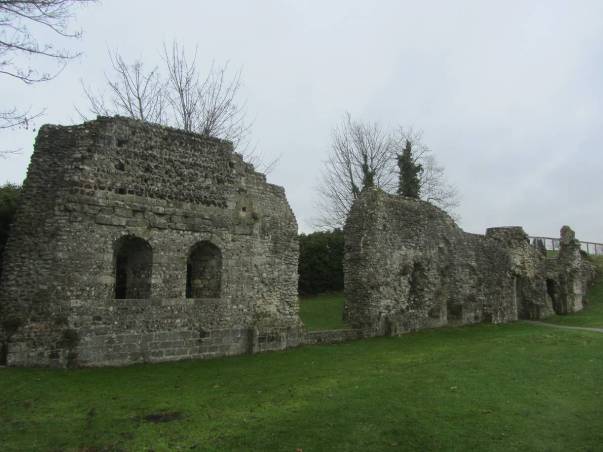
As well as building the stone castle, William de Warenne also founded an abbey – Lewes Priory – it is said on the foundations of a small Saxon Church. The new English abbey was to be a daughter of the one at Cluny, and to achieve this William himself twice had to make special requests for monks to be seconded from the mother house.
Today, the Priory’s ruins have in recent years been carefully preserved and made into a small park. However, these modest remnants mislead. In its heyday, the Priory was actually considerably grander than the castle, equivalent to Chichester Cathedral, its dormitory, 71m long by 24m wide (233 feet long by 79 feet wide), perhaps the largest in England, but the destruction undertaken during the Reformation was so thorough that today the main remnants are of marginal unconsecrated buildings – like the monks’ toilet block!
Both the castle and the ruins of the Priory are predominantly flint, but originally the Priory, built in the style of the French mother house, was clad with Caen stone shipped over from Normandy, the region immediately across the English Channel in France. This valuable building material was scavenged and reappears in two fine Lewes buildings – Southover Grange and 220-1 High Street.
The dressed Caen stone and the ‘Sussex marble’ that the Priory was made of must have been very valuable and certainly enough to justify special attention from Cromwell in the Priory’s destruction. Indeed daily reports of the progress of the work submitted by the Italian engineer, Giovanni Portinari, to Thomas Cromwell still exist, providing solid evidence of the original scale and nature of the buildings.
But, for myself, I wonder if there might be another factor to help explain the particularly harsh and through destruction of the Priory, which after all would have had two very distinct phases – the ‘official demolition’ – and the pillaging afterwards by locals. I wonder if the heavy taxation the Priory levied on all its many possessions in order to raise the Prior’s ransom – some 7000 nobles to use the old currency term - to the French would have played a part in turning local opinion against what was otherwise the region’s grandest and most magnificent religious structure.
By comparison, in 1268 the preceding Prior left £200 in his will for completion of the two western towers at the Priory, according to annals written by a Lewes monk in 1312, now held by the British Library, and in the mid 14th century the annual income of the Priory was around £1000, approximately equal to that of Westminster. The ransom – estimated by some historians to be equivalent to four times the entire annual income of England’s wealthiest religious establishment – was eventually paid and the money could come only from out of the Priory’s estates and other possessions.
Ironically, though the Priory’s continuing strong links to the French Abbey of Cluny also made it politically suspect, and a particular target for destruction under Henry VIII.
In happier times, apart of course from being hospitable to travellers, adding prestige to Lewes and providing spiritual sustenance to the community, according to Clifford Musgrave writing in Life in Brighton (The History Press, 2011) Lewes Priory “diffused education and the arts over the southern part of Sussex, fostering in particular the art of painting, of which survivals remain in the churches of Clayton, near Brighton, and Hardham.”
So, some readers may wonder, how did it come about that the Head of Lewes Priory was captured by the French? This is another example of how the small town of Lewes has played a central role in national politics.
Lewes is justly celebrated for its role in fostering internationalism – with one of its most famous residents, Thomas Paine, credited with a major contribution to the principles behind the American Revolution. Yet in its earlier period, it was one of only a handful of English towns to be razed to the ground by invaders from the Continent.
In 1377, an officially approved raiding party of the French navy landed at Rottingdean, near the then inconsequential village of Brighthlemstone. They had already attacked Winchelsea, before retreating and burning Rye - “reducing the town to ashes” but not before selecting “forty-two casks of wine” to take with them.
John of Charlieu, the Prior in charge of Lewes Priory, placed himself at the head of the local defences and fought a short and bloody battle in which a hundred of the English lost their lives, actually on the coast near the river estuary. Following this decisive victory, the French raiders quickly moved inland and ransacked Lewes. As they retreated, they took with them their prisoners, most valuable of whom was John of Charlieu.
That it was a religious man and not a knight charged with defending Lewes was unusual and was explained by the absence of Richard Fitzalan, the young Earl of Arundel, who was preparing for the coronation.
Accompanied by two knights, and with 500 men, the Prior tried to stop the French as they landed on the beaches.
“But he arrived too late and walked straight into an ambush. A hundred of the English lost their lives in the fighting and the Prior and the two knights were taken prisoner. The Prior would remain in captivity in France for a year before being released for a ransom of 7,000 nobles France, a very princely sum which saddled Lewes priory with a liability it would struggle to pay for an entire generation. As for the defence of the town itself, the French marched inland entering Lewes without difficulty and set fire to the houses before immediately retreating to the coast to leave by the next tide.”.
(Hundred Years War Vol 3: Divided Houses by Jonathan Sumption (Faber & Faber, 2011). Sumption draws on the text :The Chronica Maiora of Thomas Walsingham, 1376-1422).
In 1514, a similar fate awaited the then ‘poore village’ of Brighthelmstone (the early name for the city of Brighton today) which was also burnt entirely to the ground by the French! All except, that is, for the church, but likely only because it was made of sterner stuff. The raid is confirmed by state papers in Calais, and in retaliation the English targeted scores of French villages.
David Millum refers to an excavation in Lewes town centre which revealed a “dramatic decline in evidence after the 14th century” which he (following “Griffin 2012) suggests might be due to the impact of the Black Death on the town (1348-9) – but as we have seen, it might also and more plausibly be due to the town being razed by those French invaders.
From the end of the 13th century until the middle of the 15th century, the Priory was ‘rarely free from debt’, writes Graham Mayhew (Priory of St Pancras Lewes, edited by Graham Mayhew (2008). In 1331, the Priory’s debts were put at £5422, approximately five years income, although by 1335 it seems the Priory was almost in balance. What is clear is that in 1429 the Priory was in “dire financial straits” as Mayhew puts it, citing the cost of the Prior’s ransom to the French invaders at 7,000 nobles, or £2,333 6s 8d. – a very precise figure which conflicts with figures offered by other historians.
In fact, another Lewes Myth concerns the founder of its great Priory, Gundreda: the sixth and youngest daughter of William the Conqueror” Only she wasn’t.
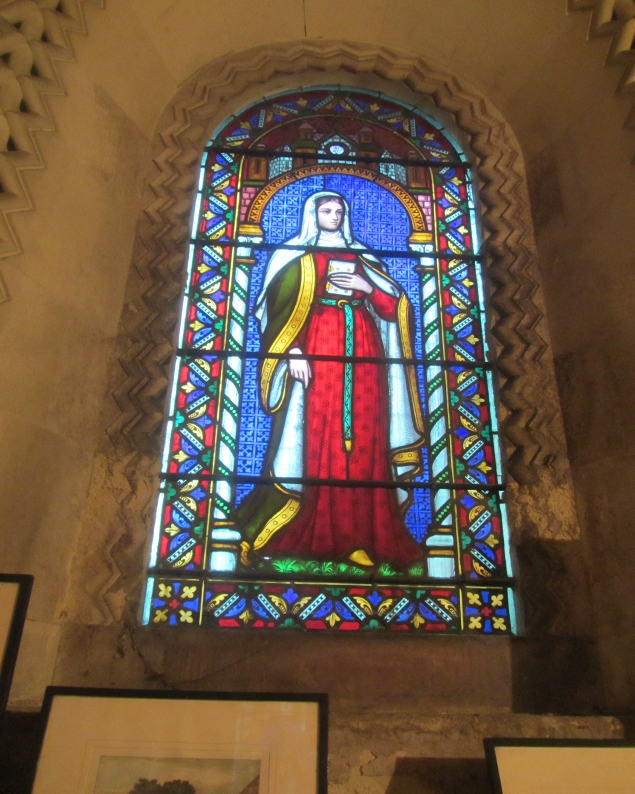
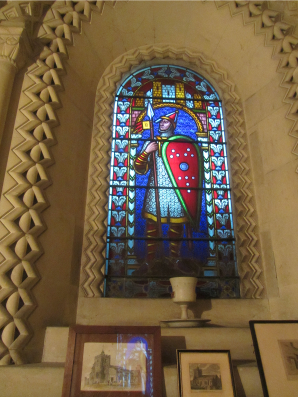
Images Gundreda and William de Warenne windows in the Gundreda Chapel in Southover Church
How did the Gundreda story get started? The contemporary wrier and historian, Tracy Borman, writes in ‘Matilda: Wife of the Conqueror, First Queen of England (Random House, 2011):
“The monks of Lewes were understandably supportive of the idea that their founder, Gundreda, was of such distinguished pedigree, so they perpetuated the theory that she was William’s daughter, and the priory records were still repeating it four centuries later. However, upon closer examination, the evidence soon begins to crumble. All of the documentary sources were compiled many years after Gundreda’s death, and the foundation charter for Lewes—which dates from the fifteenth century—may even be a fake.”
This underlines another important point for historians and archaeologists alike: ancient documents cannot be assumed to be any more reliable than more modern reports. Fake charters were commonplace at the time, often as replacements for lost originals or as a means of updating them in line with the legal requirements of the day.
Tracy Borman examines why earlier historians were confident to name Gundreda as the “sixth and youngest daughter of the Conqueror and Matilda”, noting that the belief that Gundreda was the daughter of William and Matilda evidently still prevailed in the sixteenth century. The British Library contains a sketch from around the time of Henry VIII’s reign that shows the couple with three of their sons and three of their daughters. Gundreda is included among the latter. [[ BL Harleian 1449 fo.6b. ]] The badly damaged tombstone that bore Gundreda’s epitaph was discovered at Isfield Church near Lewes in 1774 by the antiquary Sir William Burrell, who re-erected it in St. John’s Church, Southover. In 1845, her lead coffin was discovered by workmen during the construction of the Lewes and Brighton railway. It bore the inscription “Gundrada” and lay alongside that of her husband, William of Warenne, in the grounds of St. Pancras Priory, Lewes, which they had founded. The coffins were later reinterred in a specially constructed chapel at the priory. [[ H.W.C. Davis, I, p. 52; Clay, pp. 40–41, 44. ]] The Chapel, with the funeral cysts in the wall and Gundreda’s black tombstone set in the floor, can be inspected daily through a grille and entry can be requested by appointment. I was privileged to be given a full historical tour by Marcus Taylor which has helped me to prepare this article.
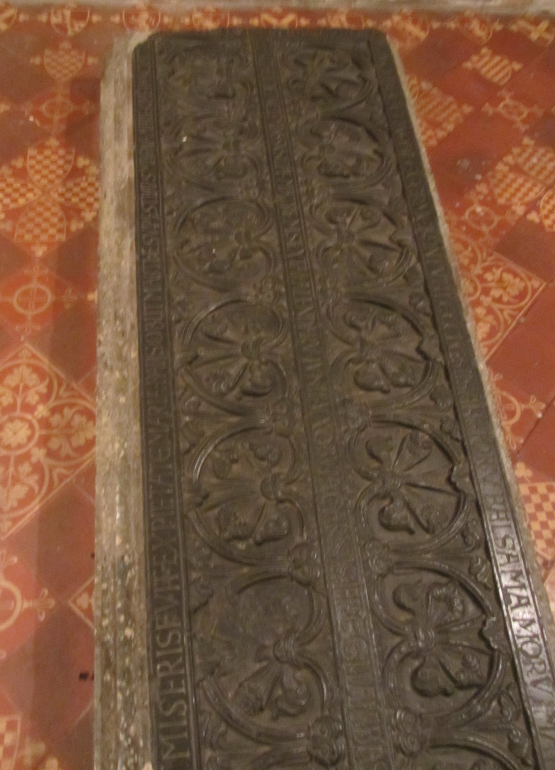
There has never been a full archaeological excavation of the extensive Priory site although there was exploratory work organised in 1845 resulting from the construction of a railway line through the church, chapter house, cloister and frater. The discoveries are reported in Lower 1846; East Sussex Historic Environment record (ESHER) Event ID: EES9015. You can read about the various investigations online at:
http://archaeologydataservice.ac.uk/archiveDS/archiveDownload?t=arch-480-1/dissemination/pdf/archaeol6-91252_1.pdf. During this, an underground chamber, referred to as the ‘Lantern’ was uncovered on the south side of the cloister which had been buried during the 18th century and graves were discovered in the chapter house, including the re-interred bones of the founders of the Priory. The discovery of lead cams and glass in the area of the dorter extension of the Priory indicates that the buildings had lead roofs and glazed windows from an early date, testimony to the wealth of the Priory. At its height, Lewes had over 100 monks and eight dependent priories, and 170 churches and chapels under its control. It had a major library and was a pilgrimage centre. It was this interest in the Priory that in fact led to the creation of Sussex Archaeological Society the following year.
Between 1900 and 1902 William St John Hope excavated at the east end of the site and discovered an 11th century church which Richard Lewis believes later became the infirmary chapel when the larger 12th century church was built.
As mentioned above, it was only because of the building of the railway line in 1845 that the lead cists of William and Gundreda de Warenne were discovered, along with many decorative tile and carved stones, but also a circular pit ten feet in diameter, 18 feet deep, filled with “several hundred human remains, almost certainly those killed during the Battle of Lewes”. This brings me, finally, to perhaps Lewes’s greatest claim to a place in history.
THE BATTLE OF LEWES: BEING A VICTORY FOR FUNDAMENTAL DEMOCRATIC PRINCIPLES
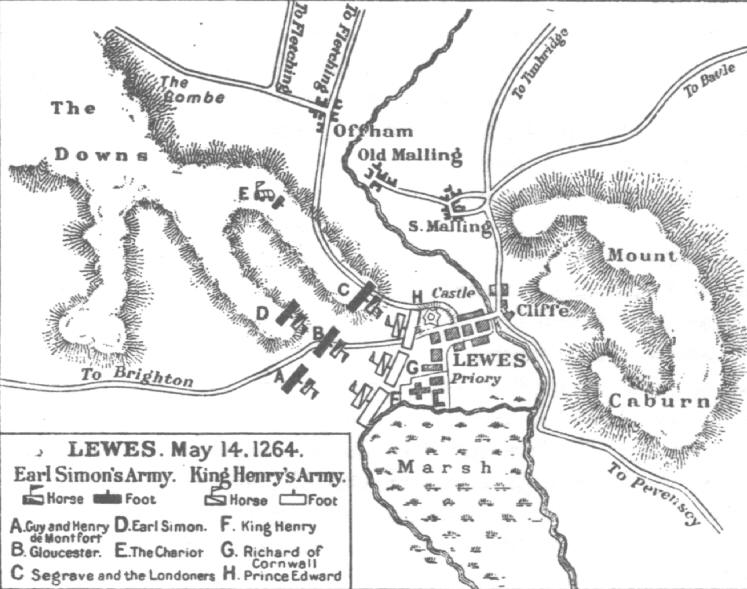
Plan of the Battle of Lewes from the Art of War in the Middle Ages by Sir Charles Oman 1898.
Everyone (okay, I use the word loosely) knows about the Magna Carta Libertatum. This is the document usually shortened to just Magna Carta, which is Latin for ‘the Great Charter of the Liberties’, signed by King John at Runnymede, near Windsor (about twenty miles from London), on 15 June 1215. However hardly anyone knows about the second crucial victory of Simon de Montfort forty-nine years later at Lewes and the Saint Valentine’s Day Parliament a few months later all of which firmly entrenched the idea that ordinary people – commoners – should also have a say in how their country was governed.
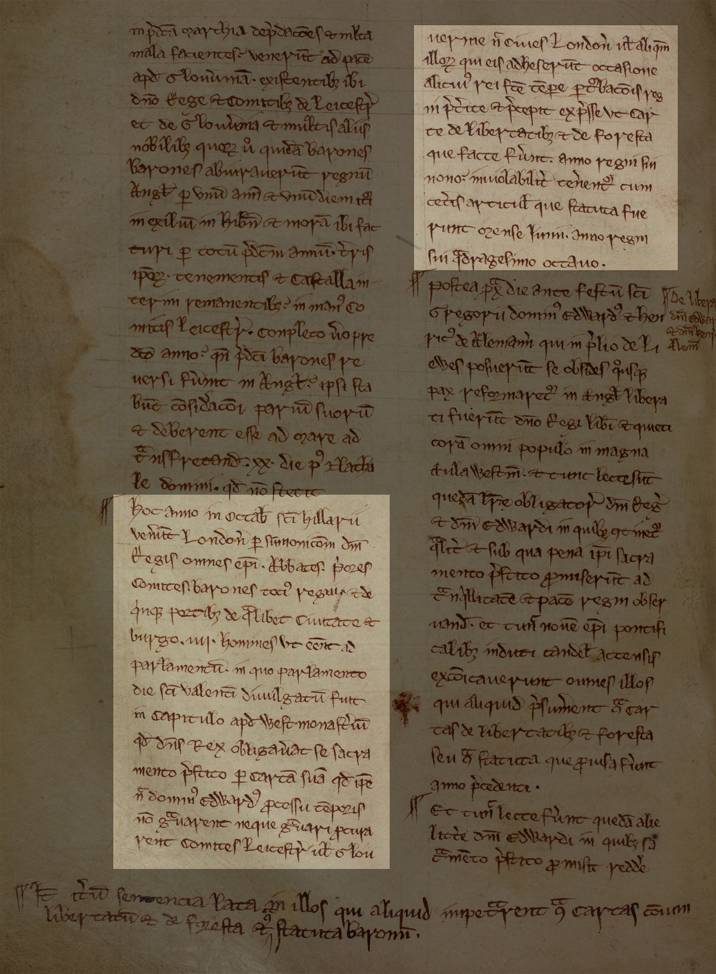
Chronicle known as Liber de Antiquis Legibus of c1274 LMA ref: COL/CS/01/001/001 permission granted to reproduce from the City of London archives.
“This year, on the Octaves of Saint Hilary [13 January], by summons of the king, all the bishops, abbots, priors, earls and barons of the whole realm, and also the barons of the Cinque Ports [representatives from the ports of Kent and Sussex], and four men of every city and borough came to London to hold a parliament. In this parliament, on Saint Valentine’s Day [14 February], it was made known in the chapter-house at Westminster, that the king had bound himself by his charter, on oath, that neither he nor his son, Prince Edward, would from thenceforth aggrieve, or cause to be aggrieved, the earls of Leicester or Gloucester, or the citizens of London, or any of those who had made alliance with them, on the pretence of anything done during the time of the past commotions [recent civil war] in the realm. And the king expressly gave orders that the charter of Liberties [Magna Carta] and the charter of the forest, which had been made in the ninth year of his reign [1225], together with the new articles [laws] which had been enacted in the month of June in the forty-eighth year of his reign [1264-1265], should be inviolably observed [enforced without exception].”
As Darren Baker, author of With All For All: The Life of Simon de Montfort, describes it:
“Although motivated as much by personal and political reasons as idealism, Simon shrewdly saw parliament as the main check on the king. When he took over the government after his success in the civil war of 1264–65, it was to parliament that he addressed his plan of government, which was in effect England’s first constitution. He later enlarged the scope of representation outside the landed elite, namely by including the wealthy merchant class of the cities, and in doing so acted like a prime minister – the first one, we can say, in English history.”
(‘10 things you might not know about Simon de Montfort’ article for History Extra, by Darren Baker, author of With All For All: The Life of Simon de Montfort (Amberley 2015)
http://www.historyextra.com/article/feature/10-things-you-might-not-know-about-simon-de-montfort).
In another historical account, part of Thomas Costain’s classic History of the Plantagenets, the moment of Simon’s triumph is captured:
“During the year following Lewes there was for a long time a comet in the sky, blood-red and shaped like a sword.
Surely on March 8, 1265, there was in the sky a great blazing sun, a sun strong enough to burn away at least one set of shackles from the wrists of men. On that day of days there assembled in London a parliament such as had never been seen before, a parliament in which common men sat and voted with lords and bishops. This truly unheard-of event was the work of Simon de Montfort. On the thirteenth of the preceding December, after holding the tiller of state with a firm hand through seven violent months, he had summoned some of the peers of the land, most of the bishops, two knights from each shire, and from two to four “good and loyal men” from each city and borough to meet and discuss the business of the realm. This was the first time in history that plain men—the socman, the franklin, the merchant, the alderman—had been judged worthy of a voice in framing the laws under which they lived.
Nothing much is known of this momentous gathering. Not a name, not a scrap of description, not the faint echo over the centuries of one spoken word: nothing but the bare outline of the one decision reached. This is unfortunate, for living history was made in Westminster Hall…”
The provisional government set up in the Peace of Canterbury gave Prince Edward back his liberty, but under restrictions essentially for good behaviour for three years - on pain of disinheritance. Both Henry and Edward specifically had to swear again to abide by the Great Charter and the Provisions of Oxford and not to seek absolution of their oaths.
“Three days later there was a solemn ceremony in the chapter house at Westminster to announce publicly that Prince Edward had been released and delivered into the keeping of his father... This ceremony marked the peak of Simon de Montfort’s power. His will had prevailed... This was the culmination of his years of steadfast adherence to an idea, long years through part of which he had stood alone. For this he had risked life and fortune; for this he had gambled on war and had dared the climb at Lewes.”
(The Magnificent Century, the second volume of Costain's A History of the Plantagenets, written in 1951).
What happened next is less auspicious. Only a year later Simon de Montfort ended up killed and his body grotesquely mutilated - his genitals cut off and stuffed in his mouth - all on the orders of Edward - the prisoner he had released in exchange for those solemnly signed covenants...
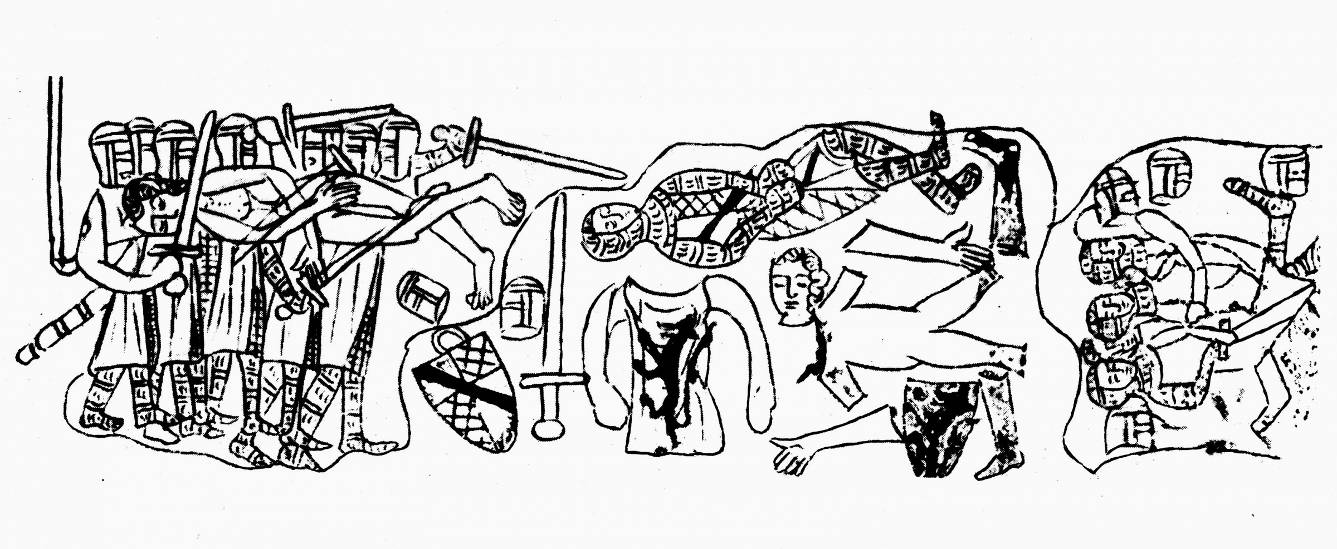
File: Body mutilated-manuscript illumination.jpg
The barbarism was, of course, part of a crude effort to destroy Simon’s reputation, and indeed Simon’s place in history has been distorted by his rivals’ propaganda ever since.
Indeed, even the story of the actual battle at Lewes has been suppressed. In fact, according to this account by David Johnson for Military History Magazine (May 2006) there were in effect two battles: one was a Calvary battle against the King’s son, Edward, which is thought to have taken place on Offham hill a quarter of a mile to the north-west of Lewes. This resulted in a rout of Simon’s forces and a gleeful pursuit by the royalists. The other, which was the crucial one, occurred between the bulk of Simon’s forces and the remnant of the royalist forces under the King on the flat river plain to the south, near the Priory. In this second battle, it was Simon and the barons who were victorious and the king who was captured. When Edward belatedly arrived to support his father, he too was taken prisoner.
David Johnson takes up the story:
“After spending a night in the Priory with his son and his followers as captives, Henry agreed on May 15 to discuss terms with Earl Simon. Throughout the day’s negotiations, priests acted as intermediaries, coming and going between the priory and Simon’s headquarters in the town of Lewes. No copy of the treaty, the Mise of Lewes, has survived, and nobody has recorded exactly what its conditions might have been...
With that agreement sealed, there remained the unpleasant task of disposing of the slain. The streets of Lewes were lined with dead and wounded, and most of the latter would also die. The abbot of St. Pancras Priory put the number of dead at 2,700, most of them peasants.”
Many years later, the grim discovery during the construction of the Lewes to Brighton railway “to the west of the prison crossroads”, of three pits full of bones and that these bones were rather disrespectfully “removed in 13 wagons to underpin the railway embankment at Southerham Corner”. These would have been the bones of some of those who fell at the Battle of Lewes.
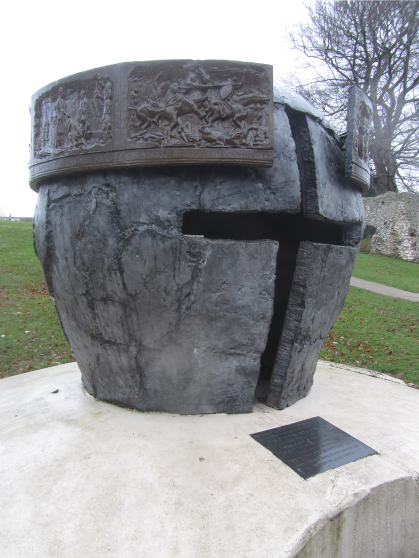
Another more edifying legacy is a song written by one of the monks at Lewes Priory, recalled by Darren Baker, again. As Mr Baker explains, the Song of Lewes is sometimes counted as “the first great masterpiece of political literature in England” although its composition in Latin has left it unknown today. In the thirteenth century though, Latin was the lingua franca of Europe and the way to spread both “the miraculous victory of Simon de Montfort over the forces of King Henry III” and the political, democratic message of Simon.
‘The faith and fidelity of Simon alone is become the security of the peace of all England; the rebels he humbles, he raises those lying in despair; the realm he reconciles, repressing the proud; he squeezes out the red juice by fighting, for truth compelled him to fight.
Thank God, he continues, because what is to become of England when Edward ascends the throne?
Treachery or falsehood whereby he is advanced he calls prudence; the way whereby he arrives, crooked though it be, is regarded as straight; wrong gives him pleasure and is called right; whatever he likes he says is lawful, and he thinks that he is above law, as though he were greater than the King.’
Lewes is thus the site not only of one of the most important battles in English constitutional history, but also, or so at least I would argue, of one of the key moments in world history. It’s an extraordinary role for a town that today seems so gentrified, and even more so when it is recalled that Lewes was also the location for Thomas Paine’s heated constitutional debates that led in due course to Common Sense, the pamphlet that again took up the rights of the common people against the ruling elites and fuelled the American revolution.
Martin Cohen is originally from Lewes and the author of many books including Political Philosophy from Plato to Mao (Pluto 2001/ 2005) which includes a description of Lewes’s surprising place in world political history. He can be contacted via twitter @docmartincohen.